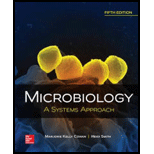
Concept explainers
Which of the following is not found in all bacterial cells?
- a. cytoplasmic membrane
- b. a nucleoid
- c. ribosomes
- d. actin-like cytoskeleton
Introduction:
Bacteria are prokaryotic organisms that either present in clusters of cells or as isolated form. The cell wall of bacteria is made up of peptidoglycan layer, they lack membrane bound organelles and exhibit asexual mode of reproduction.
Answer to Problem 1MCQ
Correct answer:
Actin like cytoskeleton is not found in all bacterial cells. Therefore, option (d) is correct.
Option (d) is given as “actin-like cytoskeleton”.
Explanation of Solution
Justify reason for the correct statement:
Structures that are found in some bacteria are S layer, fimbriae, outer membrane, cell wall, actin cytoskeleton, pilus, granule, microcompartments, plasmid, endospores and flagellum. Actin-like cytoskeleton is one of the structures that are not found in all bacteria. It consists of long protein fibers that encircle inside the plasma membrane and contribute to cell shape.
Hence, option (d) is correct.
Justify reasons for the incorrect statements:
Option (a) is given as “cytoplasmic membrane”.
Cytoplasmic membrane or cell membrane is a thin sheet of protein and lipid that surrounds the cytoplasm. It controls the flow of material in and out of the cell and found in all bacteria. Hence, it is a wrong answer.
Option (b) is given as “a nucleoid”.
It is also known as bacterial chromosome, composed of condensed molecules of DNA. DNA directs all the heredity and genetics of the cell and also codes for proteins. It is also present in all bacteria. Hence, it is a wrong answer.
Option (c) is given as “ribosomes”.
These are the tiny particles composed of RNA and protein. They are the site for synthesis of protein and present in all bacteria. Hence, it is a wrong answer.
Hence, options (a), (b), and (c) are incorrect.
The structure which is not found in all bacterial cells is actin like cytoplasm.
Want to see more full solutions like this?
Chapter 4 Solutions
Microbiology: A Systems Approach
- Identify the indicated structure (Saprolegnia). a. antheridium O b. oospore c.sperm d. auxospore e. tetraspore Of. zygosporearrow_forwardUsing information from the primary literature (several references have been provided as a starting point below) please answer the following question: Based on your review of the literature on rewilding, what are the major scientific pros and cons for rewilding? Please note that the focus of this assignment are the (biological) scientific issues associated with rewilding. As will be discussed in class, there are a number of non-scientific issues involved or implicated in rewilding, all ultimately affecting the public acceptability of rewilding. Although these issues are important – indeed, critical – in this assignment you should focus on the biological science issues and questions. Details: You must enumerate at least two pros and at least two cons. Your answer should be no more than 500 well-chosen words, excluding references. Think carefully about how best to organize and structure your answer. Aim for high information density: say a lot, but say it succinctly. Recall Nietzche’s…arrow_forwardUsing information from the primary literature (several references have been provided as a starting point below) please answer the following question: Based on your review of the literature on rewilding, what are the major scientific pros and cons for rewilding? Please note that the focus of this assignment are the (biological) scientific issues associated with rewilding. As will be discussed in class, there are a number of non-scientific issues involved or implicated in rewilding, all ultimately affecting the public acceptability of rewilding. Although these issues are important – indeed, critical – in this assignment you should focus on the biological science issues and questions. Details: You must enumerate at least two pros and at least two cons. Your answer should be no more than 500 well-chosen words, excluding references. Think carefully about how best to organize and structure your answer. Aim for high information density: say a lot, but say it succinctly. Recall Nietzche’s…arrow_forward
- Now draw a rough sketch of what the control data might look like if in addition to the specific binding, there was also a considerable amount of nonspecific binding (again using a normal dose/response curve) (do % total bound ligand vs concentration)arrow_forwardWhat are functions of cuboidal cells in the kidney? Select all that apply. Concentration of gases Dilution of chemicals Secretion of molecules Nutrition to tissues Support of tissues Absorption of moleculesarrow_forwardquestion1 In plants, epithelial tissue is only found as the outermost cell layer and acts as a barrier. In humans, epithelial tissue is found inside the body as well as on the surface. What function(s) does/do epithelial tissue carry out in humans? Select all that apply. Waste storage Filtration Oxygen transport Protection Diffusion Osmosis Absorptionarrow_forward
- What words best describes this organism? a. Unicellular/nonmotile Ob. unicellular/motile c. colonial/nonmotile d. colonial/motile e. multicelluar O f. siphonous g. none of thesearrow_forwardIdentify the phylum or class. a. Euglenophyta b. Dinoflagellata c. Bacillariophyceae d. Oomycetes e. Phaeophyceae O f. Myxomycota g. Xanthophyceae ○ h. Chrysophyceae i. Dictyosteliomycota O j. Rhodophyta Ok. Chlorophyceaens I. Charophyceaensarrow_forwardWhat is produced inside the indicated structure (Fucus). a. eggs O b. antheridia ○ c. sperm d. zygotes e. none of thesearrow_forward
 Comprehensive Medical Assisting: Administrative a...NursingISBN:9781305964792Author:Wilburta Q. Lindh, Carol D. Tamparo, Barbara M. Dahl, Julie Morris, Cindy CorreaPublisher:Cengage Learning
Comprehensive Medical Assisting: Administrative a...NursingISBN:9781305964792Author:Wilburta Q. Lindh, Carol D. Tamparo, Barbara M. Dahl, Julie Morris, Cindy CorreaPublisher:Cengage Learning
 Concepts of BiologyBiologyISBN:9781938168116Author:Samantha Fowler, Rebecca Roush, James WisePublisher:OpenStax College
Concepts of BiologyBiologyISBN:9781938168116Author:Samantha Fowler, Rebecca Roush, James WisePublisher:OpenStax College Biology 2eBiologyISBN:9781947172517Author:Matthew Douglas, Jung Choi, Mary Ann ClarkPublisher:OpenStax
Biology 2eBiologyISBN:9781947172517Author:Matthew Douglas, Jung Choi, Mary Ann ClarkPublisher:OpenStax





